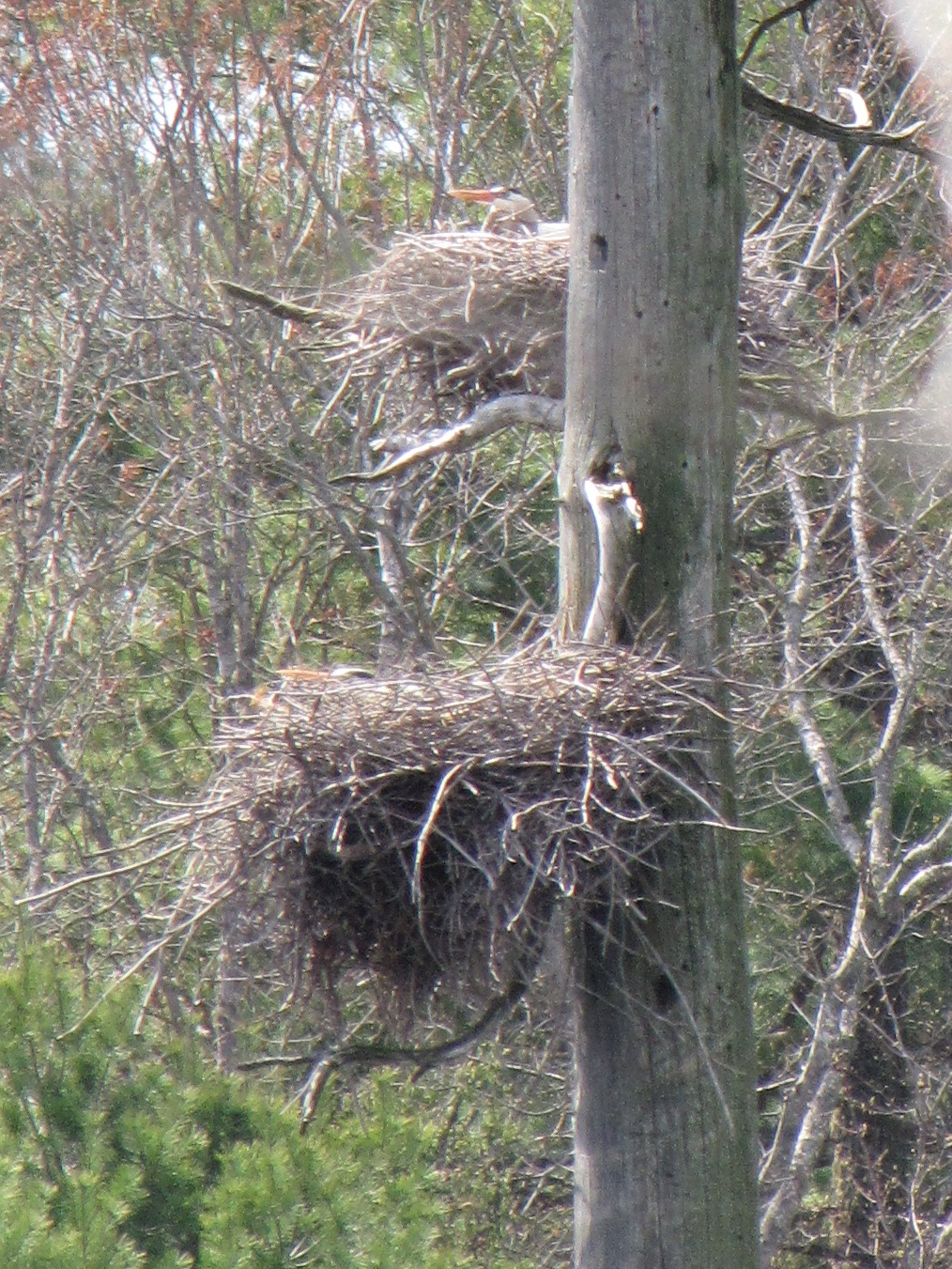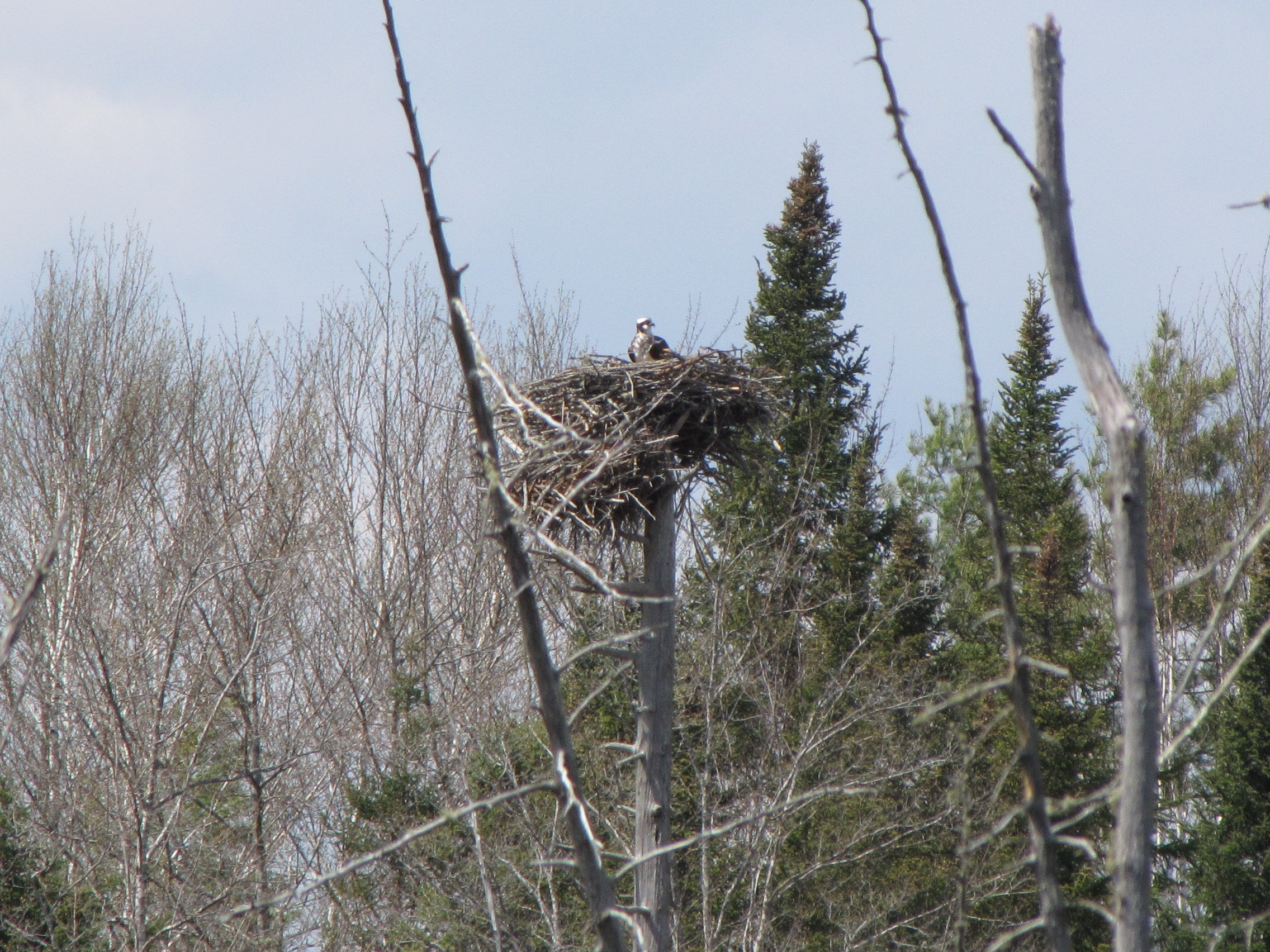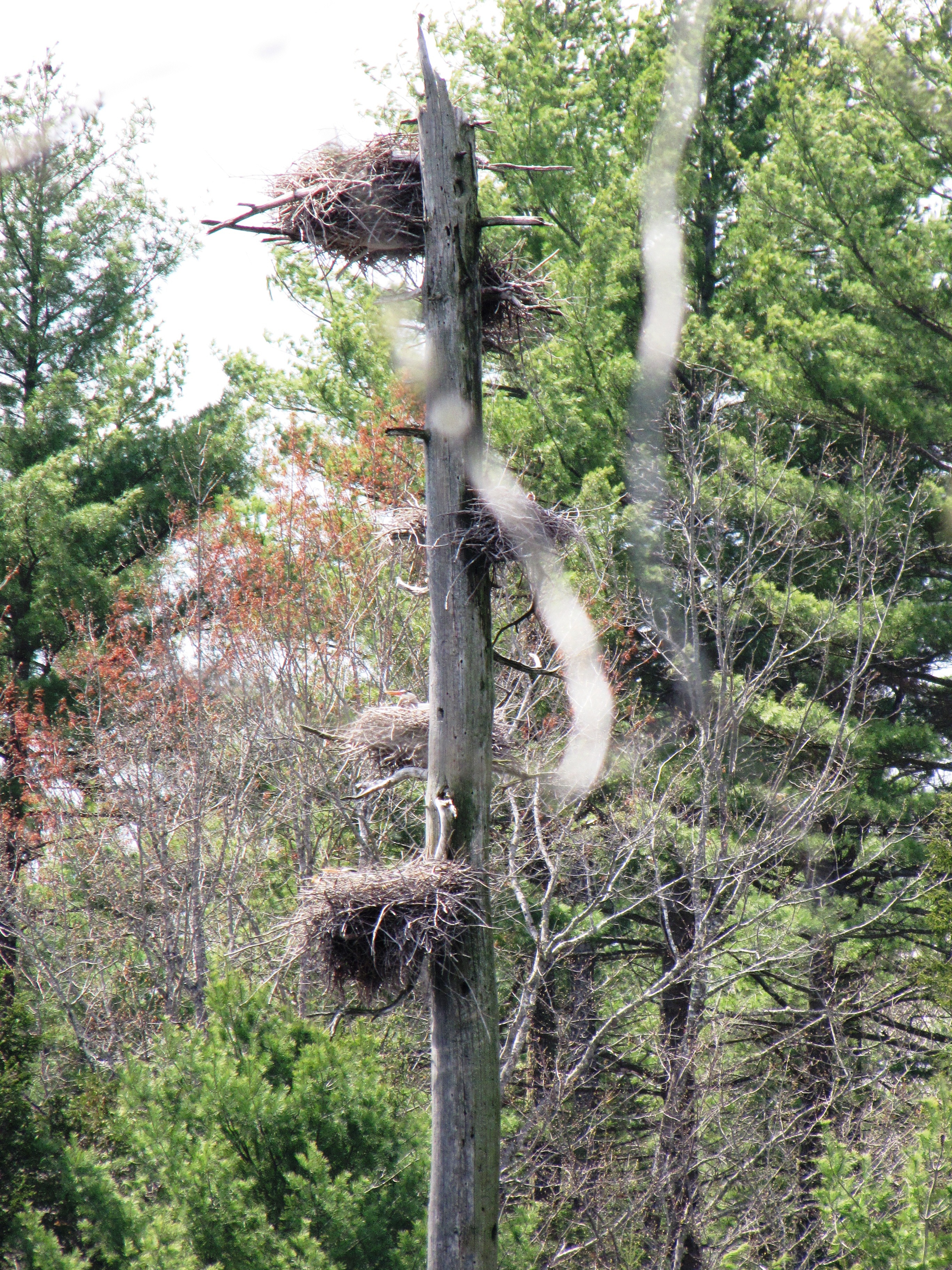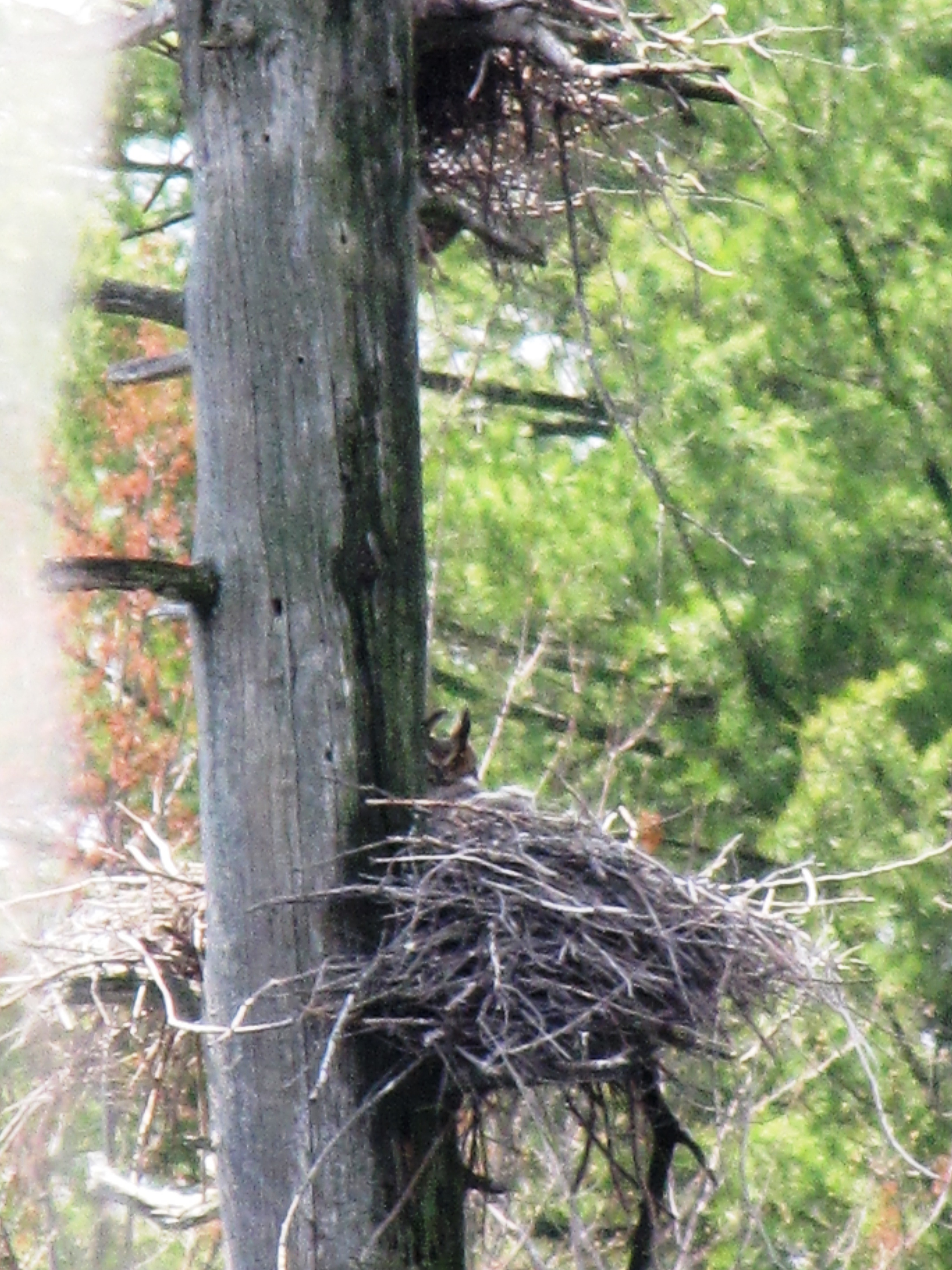May 1, 2012 at 12:05 pm
 Last Wednesday I took to the field to check out a great blue heron colony that I have only seen once during an aerial survey in 2009. Since then, a volunteer has been monitoring the colony on the ground. I finally made personal contact with the landowners this year and made a date to meet them and take a walk through the woods to the beaver flowage that housed the snags that held the heron nests.
As we approached the wetland, we quieted ourselves knowing that our presence could easily disturb the nesting herons. We ducked in and out of brush and young trees and snuck our way stealthily towards an opening at the water’s edge.
[caption id="attachment_851" align="alignleft" width="225" caption="Adult great blue herons during incubation."]
Last Wednesday I took to the field to check out a great blue heron colony that I have only seen once during an aerial survey in 2009. Since then, a volunteer has been monitoring the colony on the ground. I finally made personal contact with the landowners this year and made a date to meet them and take a walk through the woods to the beaver flowage that housed the snags that held the heron nests.
As we approached the wetland, we quieted ourselves knowing that our presence could easily disturb the nesting herons. We ducked in and out of brush and young trees and snuck our way stealthily towards an opening at the water’s edge.
[caption id="attachment_851" align="alignleft" width="225" caption="Adult great blue herons during incubation."] [/caption]
We saw one heron fly up from its nest, circle around above the wetland, then quickly return to its nest. This wetland is full of dead standing trees, or snags, but most of them are little spindly things not strong enough to support the large stick nests that herons build. Intermixed with the spindly spires, stood several trees on which several herons chose to build their nests.
I began to scan the trees looking for nests, counting as I went, and cataloguing which nests were active (or had herons sitting in them), and which were not. Several trees held one nest each, but there were a few trees that were tall and stout enough, with just the right horizontal limbs to support multiple nests. One tree had two nests, one had four, and one had five!
By late April and early May, most great blue herons inMainehave laid their eggs and have started incubating them. Incubating herons can be extremely difficult to detect with the naked eye and sometimes even with binoculars or a scope. They have this amazing ability to fold their long legs, neck, and wings and tuck themselves down so far into their nest that from a human’s perspective they are practically undetectable. Undetectable - except for the bright orange bill and the white and black stripes on top of the head. This is what I look for, and what I saw last Wednesday.
[caption id="attachment_850" align="alignleft" width="300" caption="Osprey nest."]
[/caption]
We saw one heron fly up from its nest, circle around above the wetland, then quickly return to its nest. This wetland is full of dead standing trees, or snags, but most of them are little spindly things not strong enough to support the large stick nests that herons build. Intermixed with the spindly spires, stood several trees on which several herons chose to build their nests.
I began to scan the trees looking for nests, counting as I went, and cataloguing which nests were active (or had herons sitting in them), and which were not. Several trees held one nest each, but there were a few trees that were tall and stout enough, with just the right horizontal limbs to support multiple nests. One tree had two nests, one had four, and one had five!
By late April and early May, most great blue herons inMainehave laid their eggs and have started incubating them. Incubating herons can be extremely difficult to detect with the naked eye and sometimes even with binoculars or a scope. They have this amazing ability to fold their long legs, neck, and wings and tuck themselves down so far into their nest that from a human’s perspective they are practically undetectable. Undetectable - except for the bright orange bill and the white and black stripes on top of the head. This is what I look for, and what I saw last Wednesday.
[caption id="attachment_850" align="alignleft" width="300" caption="Osprey nest."] [/caption]
Out of 16 nests in this wetland, 11 were occupied by herons, all incubating. Three nests were inconclusive – no sign of an adult heron. The largest nest on the far end of the wetland was occupied by a pair of osprey, which is not an uncommon occurrence. And the last nest? Well, this is where it gets interesting.
Remember the tree with 5 nests? As I scanned that tree from top to bottom, checking each nest as I worked my way down, here’s what I saw: a nest with an incubating heron, a vacant nest, a nest with an adult great horned owl and a fuzzy owlet, a nest with an incubating heron, and another nest with an incubating heron. Wait a minute! An adult great horned owl AND a fuzzy owlet? That owl is practically nesting in its kitchen!
[caption id="attachment_853" align="alignleft" width="225" caption="From top to bottom: incubating heron, vacant nest, adult great horned owl and a fuzzy owlet (of course there's a twig in the way), incubating heron, incubating heron."]
[/caption]
Out of 16 nests in this wetland, 11 were occupied by herons, all incubating. Three nests were inconclusive – no sign of an adult heron. The largest nest on the far end of the wetland was occupied by a pair of osprey, which is not an uncommon occurrence. And the last nest? Well, this is where it gets interesting.
Remember the tree with 5 nests? As I scanned that tree from top to bottom, checking each nest as I worked my way down, here’s what I saw: a nest with an incubating heron, a vacant nest, a nest with an adult great horned owl and a fuzzy owlet, a nest with an incubating heron, and another nest with an incubating heron. Wait a minute! An adult great horned owl AND a fuzzy owlet? That owl is practically nesting in its kitchen!
[caption id="attachment_853" align="alignleft" width="225" caption="From top to bottom: incubating heron, vacant nest, adult great horned owl and a fuzzy owlet (of course there's a twig in the way), incubating heron, incubating heron."] [/caption]
Great horned owls are potential predators of great blue herons. But, as I stood at the edge of the wetland looking on in wonder, there was no sense of predator-prey strife here. The herons were sitting low in their nests in incubating posture as you would expect and the owl just stood by in its nest with its young next to it. No signs of stress at all.
My bird brain says that owls and herons shouldn’t nest next to each other, and especially not in the same tree, at least not for the herons’ sake. You would think that the owl might choose to nest near the herons, but not vice versa. However, it is the owl who arrived and chose its nest first this year. Great horned owls use stick nests built by other birds such as hawks, ravens, and herons. The owl began nesting in February when the herons were somewhere well south ofMaine. The herons likely arrived back in late March or early April. Despite the owl taking up residency in the herons’ colony, the herons chose to nest here again. And for some reason unbeknownst to me, they even chose to nest in the same tree as the owl. Talk about tempting fate!
Perhaps there is something about this wetland that makes it a prime site for nesting herons; something that overrides the risk of nesting with a potential predator. I have heard it suggested that the owls may serve to keep mammalian predators away, or that the herons may serve to keep crows away (have you seen how ruthless crows can be to owls?). Great horned owls are known as potential predators of great blue herons. Those who follow the Cornell heron webcam know that a great horned owl attacked the incubating adults several times this year already. I do know of a heron colony that one year hosted herons and the next year only a great horned owl and no herons; so in that case the herons did not choose to nest near the owls – their tie to that colony did not override the possibility of becoming the owls’ dinner.
Despite the many possible reasons why these birds are nesting within a few feet of each other, I can’t wait to find out how the season progresses. I will keep you posted with my observations.
[caption id="attachment_855" align="aligncenter" width="500" caption="Old heron nest occupied by adult great horned owl and its fuzzy owlet."]
[/caption]
Great horned owls are potential predators of great blue herons. But, as I stood at the edge of the wetland looking on in wonder, there was no sense of predator-prey strife here. The herons were sitting low in their nests in incubating posture as you would expect and the owl just stood by in its nest with its young next to it. No signs of stress at all.
My bird brain says that owls and herons shouldn’t nest next to each other, and especially not in the same tree, at least not for the herons’ sake. You would think that the owl might choose to nest near the herons, but not vice versa. However, it is the owl who arrived and chose its nest first this year. Great horned owls use stick nests built by other birds such as hawks, ravens, and herons. The owl began nesting in February when the herons were somewhere well south ofMaine. The herons likely arrived back in late March or early April. Despite the owl taking up residency in the herons’ colony, the herons chose to nest here again. And for some reason unbeknownst to me, they even chose to nest in the same tree as the owl. Talk about tempting fate!
Perhaps there is something about this wetland that makes it a prime site for nesting herons; something that overrides the risk of nesting with a potential predator. I have heard it suggested that the owls may serve to keep mammalian predators away, or that the herons may serve to keep crows away (have you seen how ruthless crows can be to owls?). Great horned owls are known as potential predators of great blue herons. Those who follow the Cornell heron webcam know that a great horned owl attacked the incubating adults several times this year already. I do know of a heron colony that one year hosted herons and the next year only a great horned owl and no herons; so in that case the herons did not choose to nest near the owls – their tie to that colony did not override the possibility of becoming the owls’ dinner.
Despite the many possible reasons why these birds are nesting within a few feet of each other, I can’t wait to find out how the season progresses. I will keep you posted with my observations.
[caption id="attachment_855" align="aligncenter" width="500" caption="Old heron nest occupied by adult great horned owl and its fuzzy owlet."] [/caption]
[/caption]Categories